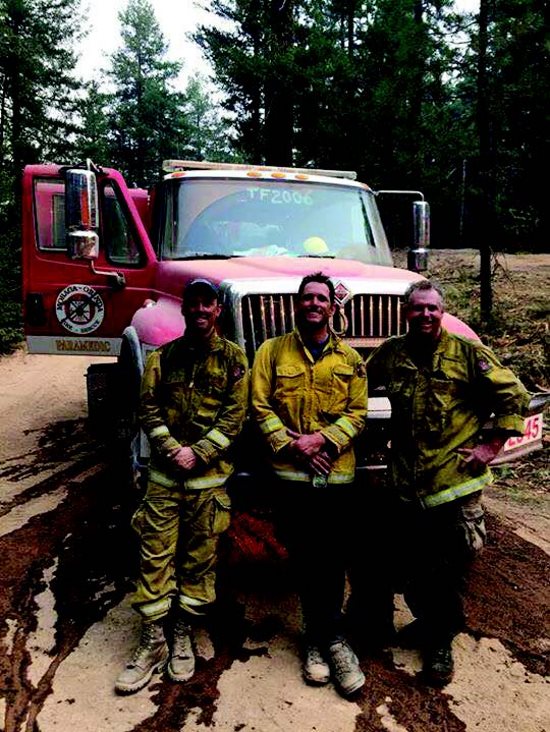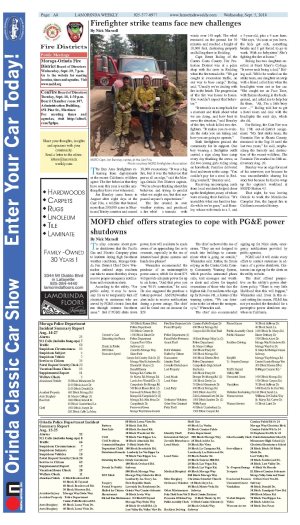| | Published September 5th, 2018
| Firefighter strike teams face new challenges
| | | By Nick Marnell |  | | MOFD Capt. Jon Bensley, center, at the Carr Fire. Photo courtesy MOFD Firefighters Association |
The Bay Area firefighters returning from deployments at the recent California wildfires agree: The fire behavior that they have seen this year is unlike anything they have ever witnessed.
 Jon Bensley came home in August after eight days at the Carr Fire, a wildfire that burned more than 200,000 acres in Shasta and Trinity counties and caused 38,000 evacuations. "It was a big fire, but it was the behavior that put us all on edge," said the Moraga-Orinda Fire District captain. "We're always thinking about fire behavior, and trying to predict what we might see, but that surpassed anyone's expectations."
Jon Bensley came home in August after eight days at the Carr Fire, a wildfire that burned more than 200,000 acres in Shasta and Trinity counties and caused 38,000 evacuations. "It was a big fire, but it was the behavior that put us all on edge," said the Moraga-Orinda Fire District captain. "We're always thinking about fire behavior, and trying to predict what we might see, but that surpassed anyone's expectations."
 The fire created its own weather system, and produced a fire whirl - a tornado - with winds over 140 mph. The whirl remained on the ground for 30 minutes and reached a height of 18,000 feet, destroying property and killing three in Redding.
The fire created its own weather system, and produced a fire whirl - a tornado - with winds over 140 mph. The whirl remained on the ground for 30 minutes and reached a height of 18,000 feet, destroying property and killing three in Redding.
 Capt. Brent Boling of the Contra Costa County Fire Protection District was at a pizza shop with his crew in Redding when the fire tornado hit. "We got caught in evacuation traffic, on our way to base camp," Boling said. "Usually we're dealing with fire in the brush. The progression of this fire was house to house. You wouldn't expect that behavior."
Capt. Brent Boling of the Contra Costa County Fire Protection District was at a pizza shop with his crew in Redding when the fire tornado hit. "We got caught in evacuation traffic, on our way to base camp," Boling said. "Usually we're dealing with fire in the brush. The progression of this fire was house to house. You wouldn't expect that behavior."
 "It reminds us to step back for a moment and think about what we are doing, and how best to serve the situation," said Bensley of the fire, which killed two firefighters. "It makes you re-evaluate the risks you are taking and how you are going to operate."
"It reminds us to step back for a moment and think about what we are doing, and how best to serve the situation," said Bensley of the fire, which killed two firefighters. "It makes you re-evaluate the risks you are taking and how you are going to operate."
 Both firefighters praised the community for its support. One boy wearing a firefighter outfit carried a sign along base camp every day thanking the crews, as did two young girls riding along on horseback. Families delivered food and treats to the camp. "You couldn't pay for a meal in Redding yourself," Bensley said.
Both firefighters praised the community for its support. One boy wearing a firefighter outfit carried a sign along base camp every day thanking the crews, as did two young girls riding along on horseback. Families delivered food and treats to the camp. "You couldn't pay for a meal in Redding yourself," Bensley said.
 Receiving encouraging cards from local residents helped cheer up the firefighters, many of whom were missing their families. "It's incredible what our families handle while we're gone," said Bensley, whose wife tends to a 5- and a 3-year-old, plus a 4-acre farm. "She says, 'As soon as you leave, the kids get sick, something breaks and I get forced to go to work. With no babysitter.' She's fighting the fire at home."
Receiving encouraging cards from local residents helped cheer up the firefighters, many of whom were missing their families. "It's incredible what our families handle while we're gone," said Bensley, whose wife tends to a 5- and a 3-year-old, plus a 4-acre farm. "She says, 'As soon as you leave, the kids get sick, something breaks and I get forced to go to work. With no babysitter.' She's fighting the fire at home."
 Boling has two daughters enrolled at Saint Mary's College. "It never ends being a dad," Boling said. While he worked on the strike team, one daughter on a trip with a friend called him when the headlights went out in her car. "She caught me on Face Time, with flames shooting in the background, and asked me to help her fix them. 'Ah, I'm a little busy now ...'" Boling told her to get a hotel room and deal with the headlights the next day, which she did.
Boling has two daughters enrolled at Saint Mary's College. "It never ends being a dad," Boling said. While he worked on the strike team, one daughter on a trip with a friend called him when the headlights went out in her car. "She caught me on Face Time, with flames shooting in the background, and asked me to help her fix them. 'Ah, I'm a little busy now ...'" Boling told her to get a hotel room and deal with the headlights the next day, which she did.
 For Boling, the Carr Fire was his 17th out-of-district assignment. "My first strike team, the Fountain Fire in Shasta County, remained in the Top 10 until the last two years," he said, emphasizing the ferocity and destruction of the recent wildfires. The Fountain Fire marked its 26th anniversary Aug. 20.
For Boling, the Carr Fire was his 17th out-of-district assignment. "My first strike team, the Fountain Fire in Shasta County, remained in the Top 10 until the last two years," he said, emphasizing the ferocity and destruction of the recent wildfires. The Fountain Fire marked its 26th anniversary Aug. 20.
 Bensley was on edge for most of his interview, not because he was uncomfortable sharing his story but because he had to wrap up his captain's workload at MOFD Station 43.
Bensley was on edge for most of his interview, not because he was uncomfortable sharing his story but because he had to wrap up his captain's workload at MOFD Station 43.
 That night, he was leaving Orinda to work the Mendocino Complex Fire, the largest fire in California recorded history.
That night, he was leaving Orinda to work the Mendocino Complex Fire, the largest fire in California recorded history.

|
| | | | | | | | | | | | |



